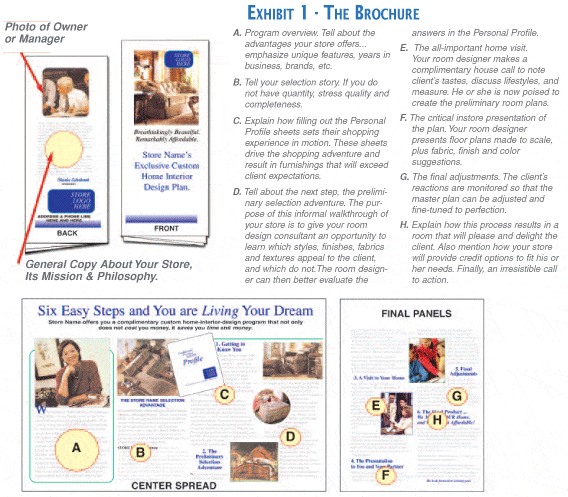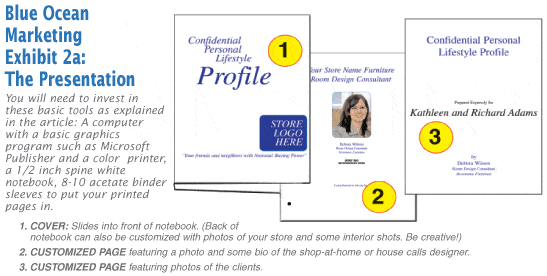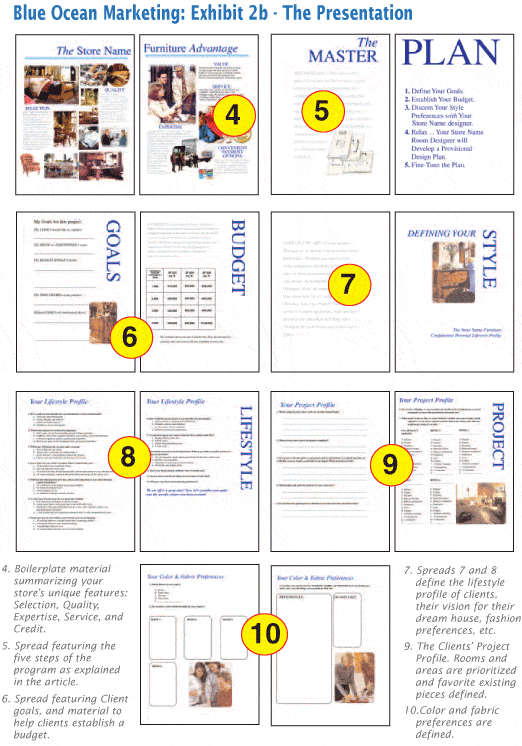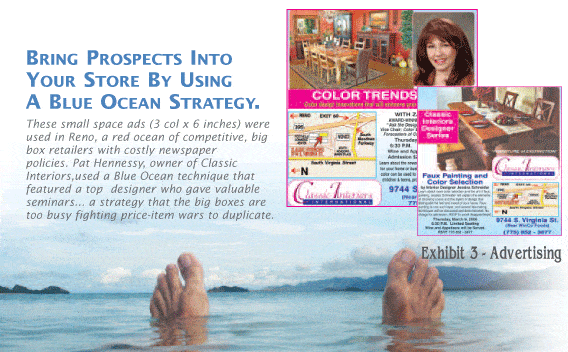NEW CONCEPT - BLUE OCEAN
Furniture Marketing
Part 2: How To Apply A Whole New Concept Of Furniture Marketing and Make Your Competition Irrelevant.
Advertising Magic by Larry Mullins
In the first part of this series that ran in the August/ September issue of FURNITURE WORLD (posted to the furninfo.com site), it was suggested that for independent furniture retailers, enlightened marketing is not about beating the competition. Retailers that go toe-to-toe with the big boxes often find themselves in a blood-red ocean of kill or be killed. A better approach is to work to make competitors irrelevant by using your time, imagination and resources to create uncontested market space through “Blue Ocean” innovations. The concept is based upon research presented in Blue Ocean Strategy, a book by W. Chan Kim and Renée Mauborgne. Based on studies of 150 strategic positions taken by companies spanning more than 100 years and 30 different industries, Blue Ocean Strategy takes a different approach than Jim Collin’s Good to Great. Rather than focusing on so-called “great” companies, Blue Ocean examines corporate breakthroughs. After years of careful research, Kim and Mauborgne were unable to find any consistently excellent companies over the long haul.
These findings agree with my own observations about the furniture industry. When it comes to furniture giants, perhaps no other industry better exemplifies that “all glory is fleeting.” Years ago Levitz introduced an invincible concept called the Warehouse-Showroom. This was a great innovation that seemed to sweep the nation—but one that was not followed by anything dramatic and eventually landed in the dust bin of furniture history. If you have been around for a while, you have seen many such scenarios acted out on the stage of furniture retailing. Most of the “great” furniture companies come and go as lesser management takes over from the original pioneers. However, there seems to be a thread of innovative crossover ideas that have their day in the sun and then fade into obscurity as something new takes hold.
Many readers seemed to get this notion, but did not see a way to make a Blue Ocean strategy work for them. Some practical applications will be presented in this final article on the subject. But first, a caution. Too many furniture entrepreneurs begin with the eye of the tiger and then lose their vitality and passion for the business. They are no longer in the store, ever, at peak business times, the weekends. Their hours are set for their own convenience, not by the needs of their customers and associates. For example, Sunday is the best furniture selling day—per hour—than any day of the week. A few furniture store owners are very religious and don’t want to do business on Sunday. These are exceptions. Many of the smaller independents in smaller cities claim that customers in their city don’t shop for furniture on Sundays. Yeah, right. Not when the store is always closed. Couples in their city who want to look for furniture together have no choice but to make the long drive to the big boxes on Sunday.
My point is that, to create Blue Ocean trends you must be consistent and dedicated. You cannot execute any Blue Ocean program unless you are willing to commit the resources, time and energy to make it work. The shop-at-home concept was mentioned in the last FURNITURE WORLD article, and a few readers wanted to know how to execute this program. Shop-at-home is a perfect home furnishings Blue Ocean idea. It begins with an assumption that your competitors buy into, and it examines this assumption with new eyes.
Is it really cost-effective in the long term to spend ten percent of your gross to flood the market with mediocre, look-alike and sound-alike advertising programs? Or is there a better way to find home furnishings prospects and address their needs? Indeed there is, and shop-at-home is one excellent example.
How to Plan a Program
STEP ONE - Select And Train A Key Associate: A successful shop-at-home program has two paramount requisites: at least one sales associate who is willing to train in interior design, and a store owner who is willing to pay for it. There is one thing we know about the young people entering the work force today: they want specialized training. And, in general, they are willing to acquire it on their own time. If you want to decrease turnover, invest in more training. Few sales people know their products in a fast track big box today. Indeed, if there is a glaring deficiency in many promotional big boxes, it is in the area of product knowledge, and the relationship of product features to benefits. You can capitalize on this weakness. One big promotional outfit in Denver actually discourages their sales staff from acquiring product knowledge, advocating instead, the mantra: “what you see is what you get.”
Choose at least one sales consultant on your floor who will be willing to learn more and develop a new level of professionalism in marketing home furnishings. The most critical decision you must make is picking the right individual to spearhead a shop-at-home program. Dispel his or her fears that it takes an artistic genius to design a room. It does not.
Assure them that it is relatively easy to acquire knowledge about the basic principles of room design. For example, very few sales consultants today have essential knowledge about the basics of color. They are not able to tell their clients that any two colors can be used together, provided one is dominant. And adding a complementary accent color is easy and fun. Explain to them that—once they learn the basics—they can teach their customers how to marry the elements of color, texture, finish and shape to produce a unique expression of the customer’s personality with the beautiful home furnishings from your store.
Stay tuned for a fantastic series on interior design concepts that will debut in the december/ January issue of FURNITURE WORLD Magazine. This series by Margarett DeGange, M.Ed., will be titled, “Decorating School Crash Course”, and will include information on the following topics:
- Simple but Sensational Seminars: How to Present them from Start to Finish.
- Color Psychology 101: How Color Choice Affects the Mood in Your Home.
- Style Savvy: Identifying the 4 Main Decorating Styles—Choose The One You Love.
- Center Stage: Show Stopping Design Through Understanding Focal Points.
- Furniture Placement: Strategies to Bring Your Room to Life: Know them to Live Well.
- Successful Accessorizing: Winning Strategies to Show-Off Furnishings and “Wow” Your Friends.
- The Fabric of Our Lives: Pattern and Texture Choices that Wear Well and Feel Right.
Of course appropriate and replete basic training in room design will take some time. While this is taking place you can begin preparations for your own shop-at-home profit center. The basic requirements, other than what you already have, are simple. A space, a desk, a good computer, digital camera, and color printer. Instead of some tired old handouts with boring information about decorating that no one ever reads, you need to produce something fresh and sparkling that brands your company head and shoulders above competition. And do it at very little cost. In fact, for less than five dollars worth of supplies, you can give a shop-at-home prospect a knock-out custom presentation (exhibits 2a & 2b below).
There are two assumptions that you must address to launch your program. First, that it takes a lot of expensive advertising to bring qualified customers in your door. Second, that you must cut prices or offer outrageously costly credit programs to sell them. Blue Ocean always begins by examining the costly assumptions that an industry buys into. Recall that Cirque du Soleil did away with costly animal acts and circus stars and refocused their resources in a new direction.
Likewise, shop-at-home dispels the idea that expensive red ocean promotions are the only way to increase market share and build a brand.
STEP TWO - Line-Up Prospects: There is a gold mine of prospects in your mailing list. If you do not have a mailing list, you will need to move into the twentieth century before you can get to the twenty-first. I do not mean to sound harsh, but it is impossible to compete today without an up-to-date preferred customer list. One of the first duties of your home design consultant in-training will be to prepare a series of free home furnishings seminars that will take place in your store. If he or she lacks the experience at making such presentations, you can hire a pro to get the ball rolling. One small store in Reno did this successfully by personally inviting selected preferred customers without charge. They also ran a small ad inviting the general public in for a small charge (See exhibit 3 below).
Personal invitations can be done by phone or mail. It is your choice. Each in-store presentation will focus on a single design issue, such as color. You will need a flyer to pass to attendees that explains your program. This flyer should also be available as a store hand-out (See exhibit 1 below).
Use your imagination and challenge your budding design consultants to do the same. This kind of program is lots of work, but much less expensive than the red ocean alternative! And remember, properly done, closing rates for shop-at-home presentations can be as high as ninety-five percent.
STEP THREE - A Customized Presentation: The internet contains a wealth of programs and templates for actually planning a room layout.
But it is the personal touch that will give you a Blue Ocean advantage. Check out the series by Margi Kyle on preparing and presenting Techno-Presentations. Part 3 can be found in this issue and you can read previous installments posted to the article archives on www.furninfo.com.
Getting your customers to participate in this process will help to assure their ownership of the final product. The elements that your presentation will feature are five:
- Define the goals of your client.
- Establish the budget.
- Discern the style preferences of your client.
- Develop the decorating plan.
- Fine tune the plan with your client.
The shop-at-home presentation is more than just room overviews. How each room is arranged is less important than the over-arching strategic design template. If you carefully examine the final series of exhibits in this article, you will get the essential idea and be able to create your own personal program for your clients.
Once again, this is a lot of work. But I did not claim that a Blue Ocean strategy is easy, only that it is vastly more effective, challenging, fun, and productive than red ocean blood-letting. In the confines of this article, I can only give you the basic essentials of a single Blue Ocean program.
However, I can assure you that smaller stores have achieved effective shop-at-home or house-call programs with much less information than you will find in these pages. If you are interested in learning more about making house calls, inquire about a 10 part audio series on making house calls by FURNITURE WORLD contributing editor Cathy Finney. These can be downloaded (mp3 format) or purchased on CD.
Brainstorm other Blue Ocean ideas with your associates. Make no mistake, today’s young lions want to learn. They hunger for training. If you give them training and show them how to apply a personalized, customer-centered strategy to their one-on-one marketing, you will be rewarded handsomely.
In the next issue I will examine another sacred cow that deserves to be challenged … furniture customer focus groups. In a recent book, The Culture Code, international marketing guru Clotaire Rapaille reveals for the first time the breakthrough techniques he uses to improve the profits of his Fortune 100 clients. You will learn that the typical focus group attains surface data but fails to penetrate the true visceral buying motives of furniture customers. This has led to several furniture marketing disasters, as you will see.




Contributing Editor Larry Mullins has 30+ years experience in the front lines of furniture marketing. Over the past ten years he has developed a Visionary Management program that can impact the culture of an entire organization and bring it to life. He also produces state-of- the-art promotional advertising packages for everything from quick cash flow to complete exit strategies and store closings. Larry is the President of UltraSales, Inc.. Questions on any aspect of this article can be sent to Larry care of FURNITURE WORLD at mullins@furninfo.com. See more articles by Larry in the marketing management archives on furninfo.com.